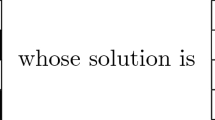Abstract
The application of a discrete Hopfield-type neural network to solving the NP-Hard optimization problem — the N-Queens Problem (NQP) — is presented. The applied network is binary, and at every moment each neuron potential is equal to either 0 or 1. The network can be implemented in the asynchronous mode as well as in the synchronous one with n parallel running processors. In both cases the convergence rate is up to 100%, and the experimental estimate of the average computational complexity is polynomial. Based on the computer simulation results and the theoretical analysis, the proper network parameters are established. The behaviour of the network is explained.
Similar content being viewed by others
References
Bizzarri AR (1991) Convergence properties of a modified Hopfield-Tank model. Biol Cybern 64:293–300.
Brandt RD, Wang Y, Laub AJ, Mitra SK (1988) Alternative networks for solving the Traveling Salesman Problem and the List-Matching Problem. ICNN: 333–340.
Hopfield JJ (1982) Neural networks and physical systems with emergent collective computational abilities. Proc Natl Acad Sci USA 79:2554–2558.
Hopfield JJ (1984) Neurons with graded response have collective computational properties like those of two-state neurons. Proc Natl Acad Sci USA 81:3088–3092.
Hopfield JJ, Tank DW (1985) ‘Neural’ computation of decisions in optimization problems. Biol Cybern 52:141–152.
Kamgar-Parsi B, Kamgar-Parsi B (1990) On problem solving with Hopfield neural networks. Biol Cybern 62:415–423.
Mańdziuk J (1993) Application of neural networks to solving some optimization problems. (in Polish) PhD Thesis, Warsaw University of Technology.
Mańdziuk J, Macukow B (1992) A neural network designed to solve the N-Queens Problem. Biol Cybern 66:375–379.
Wilson GV, Pawley GS (1988) On the stability of the Travelling Salesman Problem algorithm of Hopfield and Tank. Biol Cybern 57:63–70.
Yao KC, Chavel P, Meyrueis P (1989) Perspective of a neural optical solution to the Traveling Salesman optimization Problem. SPIE (Optical Pattern Recognition II): 17–25.
Author information
Authors and Affiliations
Rights and permissions
About this article
Cite this article
Mańdziuk, J. Solving the N-Queens problem with a binary Hopfield-type network. Biol. Cybern. 72, 439–445 (1995). https://doi.org/10.1007/BF00201419
Received:
Accepted:
Issue Date:
DOI: https://doi.org/10.1007/BF00201419




